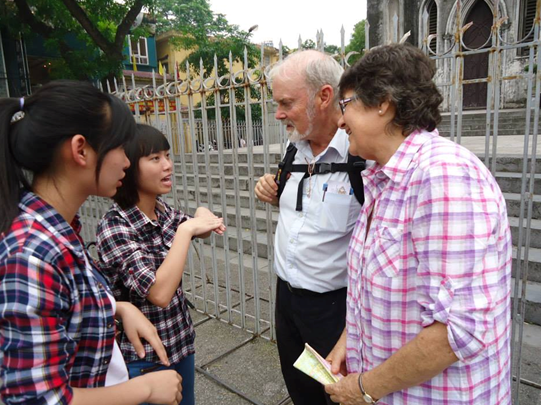Summary
Traveling to Vietnam – Learning Vietnamese: why and how?
One of our philosophies, and also one of our main goals is to offer you a unique experience, where you will live a stay in direct contact with locals, share their daily life. However, what will allow you to fully enjoy your stay is a basic knowledge of the Vietnamese language. Why? Just like, when you meet a foreigner in your country who makes an effort to speak French, the Vietnamese will be delighted to hear you speak their language, which makes you much more likeable and even adorable in their eyes. Your stay will therefore be much more pleasant. “Learning Vietnamese” will also make it easier for you to know the culture better: you will ask yourself the questions you are interested in, and will no longer be biased by the translation which, sometimes, is not very similar.

Once you learn some Vietnamese, you will be able to negotiate with local suppliers on your own, and better plan your stay in Vietnam. The reservation of plane tickets, train or hotel rooms at the best price will be at your fingertips.
Moreover, Vietnamese is the easiest Asian language to learn: its alphabet is of Latin origin, and not a hieroglyphic script like that of Chinese and Japanese. Vietnamese also does not require conjugation or grammar. The only difficulty in this learning is that it is a tonal language with 6 tones. However, these 6 tones are clearly indicated in the writing.
Learning Vietnamese will be particularly useful for an expatriation in Vietnam:
What is Vietnamese?
Vietnamese is an Austro-Asiatic language (language of Southeast Asia) influenced by Chinese in terms of vocabulary.
Vietnamese is a tonal language
A tonal language is a language where syllables are associated with tones. The majority of Asian languages are tonal. Chinese has 4 tones and Vietnamese has 6. This is the biggest difficulty for foreigners, but fluency will come with practice. It is very important to master the tones well, or at least practice them from the start of learning Vietnamese.
Vietnamese is a monosyllabic language
Unlike the French language and other languages of Latin origin, the Vietnamese language is monosyllabic. In the writing and also in the spoken language, it is for this reason that it is sometimes difficult to locate the compound words and for that, to understand the sentence in its entirety. In fact, Vietnamese has a “monosyllabic tendency”: there are words composed of two syllables (even three but very rare).
Many Vietnamese words are made up of two single words. For instance :
– xe (vehicle) + đạp (pedal) = xe đạp (bicycle)
– xe (vehicle) + máy (machine) = xe máy (motorcycle)
– xe (vehicle) + ngựa (horse) = xe ngựa (carriage)
There are thousands of words that follow this very simple rule.
Vietnamese is an insulating language
Unlike the French language, the Vietnamese language only has invariable words. There are no irregular verbs, no masculine/feminine, no articles, and a very simple grammar.
However, within the framework of this article, we invite you to learn only common Vietnamese words, which will be useful to you during your trip.
Learn polite Vietnamese!
I am French = Tôi là người Pháp [ Toï là niuoi Fap ]
Excuse me = Xin lỗi [ Xin loï ]
Yes = Vâng [ Vant ]
No = Không [ Cront]
Merci = Cảm ơn [ Came onne]
Bonjour = Xin chào [ Xin ciao ]
Please = Làm ơn [ Lame Onne]
Au Revoir = Tạm biệt [ Tamb ticket ]
See you soon = Hẹn gặp lại [ Haine Gap Laille]
France = Pháp [Fap]
Commerce
How much does it cost = Bao nhiêu [Bao Niau]
Too Expensive = Đắt quá [Date what]
I don’t buy = Tôi không mua [ Toï Cront Moua]
A Table
Bon Appétit = Chúc ăn ngon [Chuck An Nionne]
Water = Nước [Niouc]
Bread = Bánh mì [Bane Mi]
Beef = Bò [Beau]
Pork = Heo [ Hieu]
Chicken = Gà [Ga]
Coffee = Cà Phê [Coffee]
Milk = Sữa [Suau]
Learn Vietnamese on video
To prepare well for your trip to Vietnam, or just to have fun while learning Vietnamese, please see our videos in the Learn Vietnamese section.
Learn Vietnamese – Introduction: How to say Hello in Vietnamese?
Lesson 1: Tones and Basic Phrases in Vietnamese
Lesson 2: Introduce yourself and say hello
Lesson 3: Asking for age and counting in Vietnamese
Lesson 4: How to discuss prices in Vietnamese
Lesson 5: How to Order in a Restaurant
Lesson 6: Time
Lesson 7: Emotions
Lesson 8: Pronouns
Lesson 9: Vocabulary – basic verbs
